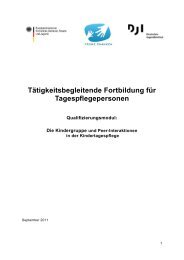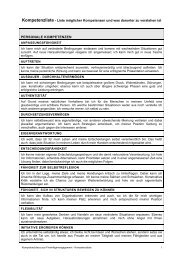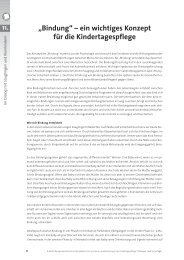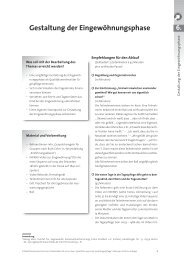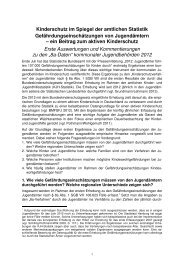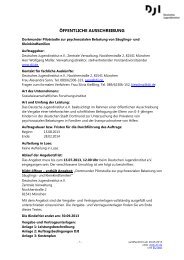download - Deutsches Jugendinstitut e.V.
download - Deutsches Jugendinstitut e.V.
download - Deutsches Jugendinstitut e.V.
Create successful ePaper yourself
Turn your PDF publications into a flip-book with our unique Google optimized e-Paper software.
national level. For example organizers of nationwide program “School of equal<br />
opportunities” which is financed from European Social Fund.<br />
Results of our activities can be considered on three levels. Participants of projects get<br />
the opportunity to develop some important abilities (over 250 000 young people<br />
participated in donated projects), people implementing projects are provided with access to<br />
valuable experience and necessary knowledge (a group of over 500 people implementing<br />
projects are now more experienced). And last, but not least, the communities, where the<br />
projects were implemented get the chance to learn from the examples of equalizing<br />
educational opportunities (thanks to ours projects over 100 non-governmental<br />
organizations were formed).<br />
The 1999 Reform of Education, as a Tool (?) of Equalizing Educational<br />
Opportunities 1<br />
Shortly about the Reform<br />
General aims of the 1999 reform of education were to:<br />
− increase the level of education of the society through popularizing secondary<br />
and higher education,<br />
− equalize an educational opportunities,<br />
− undertake actions out of concern for the quality of education considered as a<br />
integral part of the process of upbringing.<br />
One of the serious problems of the Polish educational system before the reform in 1999<br />
was a steadily decreasing number of children at school age, due to a demographic shift.<br />
The schools were more and more empty, yet the costs of maintaining them did not<br />
change.<br />
It was necessary to coordinate the management of schools with the local governments.<br />
Other problems were: the unequal level of schooling in different schools, the<br />
disproportions in educational opportunities of young people with different backgrounds<br />
and the low percentage of students in general high schools and going to universities.<br />
A change of the school system was supposed to be the remedy to many problems.<br />
Instead of the old system: 8 (years of primary school) + 4 (years of high school) it was<br />
changed into: 6 (years of primary school) + 3 (years of junior high school – gimnazjum) + 3<br />
(years of high school). Bringing junior high schools into being, was supposed to have a vital<br />
meaning for equalizing educational chances. The junior high schools were promised to be<br />
especially well equipped, so they could really act as places of making young people equal.<br />
Teachers' Opinions on the 1999 Reform<br />
According to the teachers, the goals and means of the reform were unrealistic from the<br />
very beginning. Many students cannot cope with a new, unknown school environment.<br />
The fact of going to school with children of different backgrounds might lead to<br />
equalizing chances, provided that students with different backgrounds get into contact and<br />
1 The following charter is based on the author's study of interviews with teachers. The results of this research were<br />
presented in the text: Walczak D., Zahorska M. 2006: Krajobraz po .reformie. Opinie nauczycieli na temat reformy<br />
edukacji z 1999 roku, Wrocław and they will be published in a text: Zahorska M., Walczak D., O osobliwościach<br />
nauczycielskiej duszy w: Nowak A., Winkowska–Nowak K., Rycielska L., Szkoła w dobie internetu (in print).<br />
15



